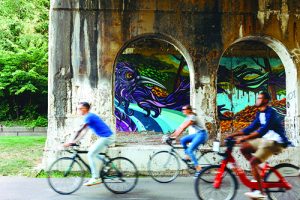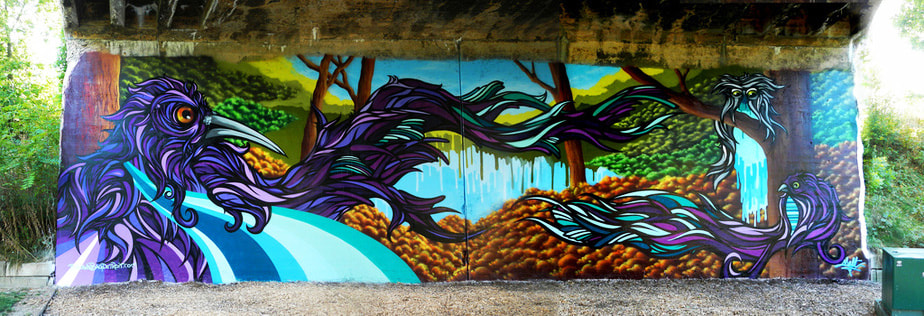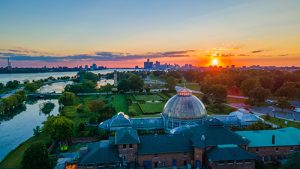By Mary McGuire
In public spaces, art is more than placemaking, it has a deeper role to play. Research tells us that public art sparks curiosity, reduces stress, provides a sense of community, and makes a positive impact on the health and well-being of the everyday citizens that interact with it. The intersection between public health and public art isn’t hard to find, it is all around us. For example, here in Michigan, we have many spaces where we are physically active, and those same spaces are home to works of public art for us to view. This art marks our location and often, our achievements. It tells a story and explains our history of place. It is meant to inspire us and enrich our moment in time. To engage with public art, we have to usually get outside (and out of our vehicles) to see it, and in this way, public art also creates an opportunity for us to add more physical activity to our lives.

The Detroit RiverWalk is a three-mile pathway along the Detroit River that links some of Detroit’s most iconic landmarks named after famous Detroiters – Aretha Franklin Amphitheater, Hart Plaza, Horace E Dodge and Son Memorial Fountain, Milliken State Park, Mount Elliott, Rivard Park, Robert C. Valade Park, and more along. Picturesque and dotted with playscapes, splashpads, and garden rooms designed as contemplative places for social interaction, the spaces invite people to be active and relax.
The rising star of the RiverWalk is a once abandoned below-grade railroad bed turned greenway. With funding from The Community Foundation for Southeast Michigan’s Greenways Initiative, Michigan Natural Resources Trust Fund, and the Michigan Department of Transportation, the old railroad bed was transformed to a glorious pedestrian greenway known as the Dequindre Cut Greenway (The Cut). Named for Antoine Dequindre, a shopkeeper born and raised in Detroit who formed a company of riflemen and was captain of the Michigan Legion during the War of 1812, it is a vibrant destination.
“Today, people walk, bike, and roll from neighborhoods like historic Lafayette Park past apartments designed by acclaimed architect Ludwig Mies van der Rohe to Detroit’s Eastern Market for fresh, healthy food,” explains MFF President and CEO Amy Ghannam. “Though, it has become more than a pathway or short cut from one place to the next, it is a place to be active, a place for community, and an incredible visual sensation.”

Rising out of what was once considered ruins, the walls of The Cut are covered in urban artwork and graffiti, illegal and commissioned. In the Motor City, where the automobile reigns, the only way to see it is in person – by getting out of the car and being active. There is a 20-foot-wide paved pathway with separate lanes for pedestrians and cyclists and colorful murals cover the walls on both sides.
An important form of visual communication, Graffiti was considered outsider art. Today it is an artform that is finally getting recognition in the art world and by everyday people.
“Creating art in a public space is the perfect way to bring my ideas to a much larger scale than the work I do in the studio,” explains Multidisciplinary Artist Rick Malt, who is known as MALT. “And being able to interact with the community when the work is being created – it’s really cool meeting local residents, hearing the comments or seeing the reactions as the art transforms from start to finish.”
Malt and the other artists that have filled the walls of The Cut use the artform to do more than express themselves, they define the space while sharing their ideas with the public on topics likes fair treatment, the environment, religion, community, pop culture, gentrification, music, history, and more. And sometimes the viewers are deeply engaged or just seeing the works briefly as they ride past.

“The Cut sits at the intersection where it is celebrated as a postindustrial tour de force in the artworld, and as an example of urban revitalization where people can be active and live healthier lives,” explains MFF Vice President of Programs Marci Scott. “It is this unique intersection of visual and physical enrichment that improves the quality of life for every person that takes the time to take in the experience.”
Just a short distance from The Cut is Belle Isle, a 2.5-mile-long, 982-acre island park on international waters in the Detroit River. Belle Isle is managed by the Belle Isle Conservancy in partnership with the Michigan Department of Natural Resources and the City of Detroit. It is home to the Belle Isle Aquarium, Anna Scripps Whitcomb Conservatory, Dossin Great Lakes Museum, Belle Isle Nature Center, James Scott Memorial Fountain, and is the southern gateway for the Iron Belle Trail.

Inspired by 19th century landscape architect Frederick Law Olmsted, other notable architects, artists, and garden designers have all contributed to the beauty of the Island. This includes 20th century greats like Albert Kahn, George Mason, Marshall Fredericks, Clarence E. Day, and Piet Oudolf. Most recently, brothers Erik and Israel Nordin, artists and founding partners at Detroit Design Center created and installed the first large scale work of 21st century art on the Island to commemorate Michigan’s 2,000-mile Iron Belle Trail.
The eight-ton sculpture was placed on Belle Isle by crane in 2022 and is called “One World….Under Michigan Stars.” The sculpture tells the story of connection and was inspired by the state’s sky, water, skylines and two peninsulas. From the bottom to the top, the Nordin brothers invite us in to view the essence of the Iron Belle Trail from Detroit to Ironwood.

“We used the elements of glass and steel our ingredients, to create an abstract view of Michigan and the trail through our lens. The design was inspired by the skylines of both Detroit and Ironwood, turned and facing one another. The negative space between the two cities symbolizes the trail. The sky is constantly changing like the trail does throughout Michigan” explains Detroit Design Center Artist and Founding Partner Erik Nordin. “The circular shape of the sculpture reflects the world…all of us together. Each of the two halves also symbolize the upper and lower peninsulas of Michigan. The grid-like pattern is inspired by a topographical view of a city. Hand-Cast Blue Glass details reflect the precious fresh water throughout Michigan.”
To understand a work of art by looking at the materials, form, color, context, and setting is one way of seeing it and appreciating it. But, understanding a work of art fully comes from also knowing what the artist meant to convey by creating it, and this gives us a richer experience.
““One World … Under Michigan Stars” reminds us that when we are anywhere on the trail, we are all together – connected by stars. The beauty of the trail is shared by us all – we are all truly connected by nature,” shares Nordin.
The Iron Bell Trail is a journey across Michigan’s varied landscape and offers two routes, one for hiking and one for biking. Nearly 70% complete, it is the longest state-designated trail in the nation extending from Ironwood in west end of Michigan’s Upper Peninsula to Detroit’s Belle Isle in the south.
“In addition to experiencing all the wonders of nature Michigan has to offer along either route, having “One World … Under Michigan Stars” to commemorate the journey is fantastic. It is a visual and placemaking statement that adds another layer to the sense of accomplishment that comes from physically experiencing the trail,” shares Ghannam.

